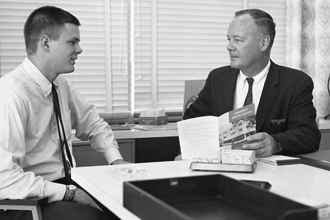Memoir by late dean of students recounts 1960s
John H. Stibbs had a story to tell: what it was like to be dean of students at Tulane University during the turbulent times of student unrest in the late 1960s.

John Stibbs, right meets with a student in 1959, shortly after the University Center (now the Lavin-Bernick Center) was built. In Stibbs' recently published memoir, he presents a record of the growth of student community life during his tenure as dean of students at Tulane from 1949â“75. (Photo from Tulane University Archives)
While the academic memoir is also available in the Stibbs Family Papers in the Louisiana Research Collection at the Howard-Tilton Library, scholar John Edgar Browning did not know this when he stumbled on the manuscript on the bookstore shelf.
This spring, A Quarter Century of Student Life at Tulane has been published as a book including Stibbs' original narrative along with administrative reports and clippings from The Times-Picayune and The Hullabaloo.
Among the controversies with which Stibbs was involved was the student outcry over his censure of photos of a nude model that were to be printed in The Hullabaloo in 1968.
After his confiscation of the photographs, the “howl” from students continued for days, but Stibbs stood firm in his decision to halt what he deemed pornography from being published by Tulane.
The protests ended when Tulane President Herbert Longenecker agreed to look into changing how The Hullabaloo was supervised by the administration.
Other events recounted by Stibbs are demonstrations against the army draft and the Vietnam War and protests over the university's withholding of official recognition for a gay students' group.
Browning writes “what I have found in Stibbs is ⦠a man whose legacy and caliber ⦠add much to the city's and the university's resilient, indefatigable character, and yet whose image among the students, to whom he dedicated everything, was slightly tarnished during the last years of his life.”
